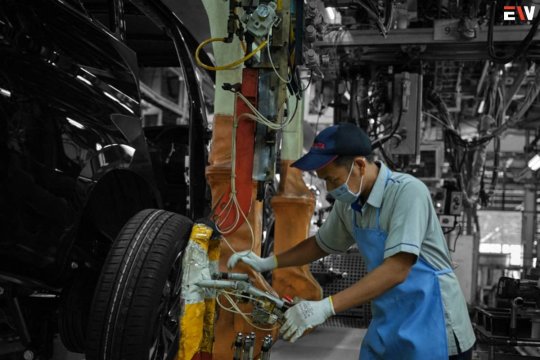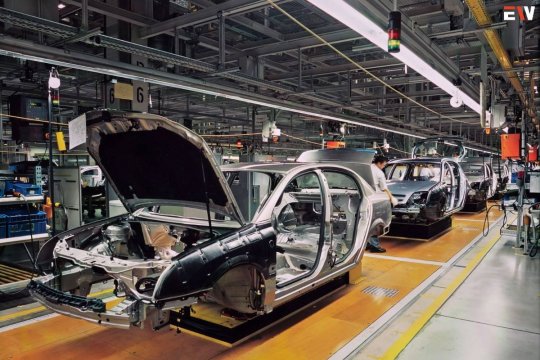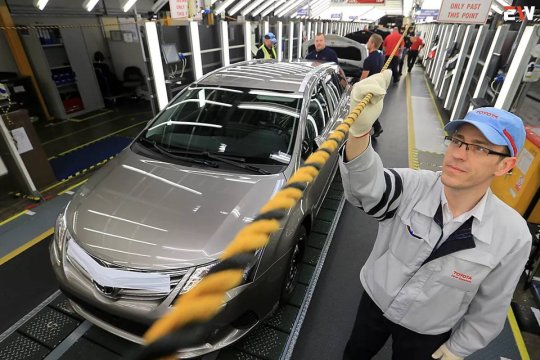#heijunka
Explore tagged Tumblr posts
Text

Adopt Lean Manufacturing tools to simplify, scale and succeed in Operational Excellence
Have a look at the dynamic and impactful lean manufacturing technologies to enhance process visibility, production flexibility, on-demand delivery and sustainable growth.
For more details read our article : https://www.linkedin.com/pulse/adopt-lean-manufacturing-tools-scale-succeed-dxxzf/?trackingId=lKt92EU9RBCE81s2TbJdMQ%3D%3D
0 notes
Text
¿Quieres optimizar tu producción y reducir el desperdicio? Descubre cómo Heijunka en la metodología Lean puede ayudarte a nivelar la producción y maximizar la eficiencia. Aprende técnicas para equilibrar la carga de trabajo y mantener un flujo constante de producción. 📊✨
#Lean Manufacturing#Heijunka#Optimización#Productividad#Eficiencia#Gestión de Proyectos#Mejora Continua#Metodología Lean#Método Lean#Industria 4.0#Copywriting
0 notes
Text
How we reduced waste of movement on an industrial site by 87%
How to optimize your process with Lean principles The term Muda is a Japanese word meaning waste. It refers to any activity that does not add value in the eyes of the customer. The Lean approach aims to reduce these wastes through continuous improvement. There are 8 types of Muda: Overproduction: Producing more than what is needed by the customer. Waiting: Time spent between tasks or within…

View On WordPress
#5S#7 Mudas#8 Mudas#Bottleneck#Gemba#Heijunka#Lead and Learn#Lean#Lean management#Lean manufacturing#Lean Strategy#Management#Mudas#Poka-yoke#Strategy#Value Chain#Value Stream#Value Stream Mapping
0 notes
Text
Heijunka Nedir?
Kelime anlamı olarak seviyelendirmek demektir. Yalın üretimdeki anlamı ise, talep dalgalanmalarından arındırılmış, her model veya çeşidin her vardiyada ve ardışık yapılabildiği, stoksuz üretim yöntemidir. Heijunka üretim sistemini sağlamanın temel yolu, model değişimi ve tezgah set-up süreleri minimize ederek daha sık model değişimi yapabilir hale gelmektir. Yani öncesinde mutlaka iyi SMED…
0 notes
Text
https://learntransformation.com/lean-manufacturing-tools/
The article outlines 30 Lean Manufacturing tools for implementation:
Value Stream Mapping: Analyze processes visually.
5S System: Organize workplace efficiently.
Kaizen: Encourage continuous improvement.
Poka-Yoke (Error Proofing): Prevent errors in processes.
Kanban System: Visualize workflow stages.
SMED (Single-Minute Exchange of Die): Optimize changeover processes.
Total Productive Maintenance (TPM): Maintain equipment effectively.
Cellular Manufacturing: Arrange equipment based on flow.
Standard Work: Document and refine procedures.
Pull Production: Trigger production based on demand.
Andon System: Alert workers of problems.
Jidoka (Autonomation): Detect abnormalities in machinery.
Heijunka (Production Leveling): Adjust production based on demand.
Root Cause Analysis: Dig deep into issues.
Visual Management: Communicate information visually.
Gemba Walks: Identify improvement opportunities.
3P (Production Preparation Process): Plan new processes effectively.
Bottleneck Analysis: Identify and alleviate constraints.
Value-Added Analysis: Distinguish value-adding tasks.
Hoshin Kanri (Policy Deployment): Align goals with operations.
Takt Time: Pace production to meet demand efficiently.
A3 Problem Solving: Define and solve problems systematically.
5 Whys: Uncover deeper causes of problems.
Just-in-Time (JIT): Ensure timely delivery of materials.
Cross-Training: Develop a flexible workforce.
PDCA Cycle (Plan-Do-Check-Act): Iterate for improvement.
Quality Circles: Focus on specific problems collaboratively.
OEE (Overall Equipment Effectiveness): Identify areas for improvement in equipment performance.
Supplier Relationship Management: Collaborate with suppliers.
Continuous Improvement Culture: Encourage innovation and learning.
Leaders should prioritize fostering a culture of continuous improvement.
0 notes
Text
Heijunka: Harmonizing Production for Peak Efficiency
In my extensive career as a Lean Six Sigma expert, Heijunka, or production leveling, has been a key principle in achieving operational stability and efficiency. Originating from the Toyota Production System, Heijunka is a method that aims to smooth out the production process, reducing peaks and troughs in demand and workload. This article will delve into Heijunka, detailing its benefits and its…

View On WordPress
0 notes
Text
Integrated WMS for Logistics Service Providers

AUTOMATION
Complete Automation across Order Streaming, Planning & Allocation, Waving and Load Planning

DASHBOARDS
Integrated Heijunka Planning and Execution Dashboard

OPTIMIZATION
Robust Optimization that includes Space Utilization, Productivity, and Dynamic Slotting

INTEGRATIONS
Ecosystem Integrations that include Robotics, AGVs, ERPs, Order Management Systems, Shopping Carts, and Carriers

MOBILITY
Mobile App that supports activities that includes picking, scanning, packing, and sorting

MULTI-INDUSTRY COMPLIANT
Record and Maintain information on all the fixed assets and monitor the change in value
Source Link
0 notes
Text
Unfolding the Secrets of the Toyota Production System

In the world of manufacturing, the Toyota Production System (TPS) stands as a paragon of efficiency and excellence. Originating in Japan but embraced worldwide, the TPS has transformed the way industries approach production, ensuring minimal waste and maximum value.
In this article, we’ll explore the intricacies of the Toyota Production System, the principles that underpin it, and how it has become a blueprint for lean manufacturing and operational excellence.
1: Understanding the Toyota Production System
The Toyota Production System, often referred to as lean manufacturing, is a comprehensive approach to production that was developed by Toyota in the mid-20th century. It is founded on the principles of continuous improvement and efficiency, with a relentless focus on eliminating waste in all aspects of production.
Key Elements of the Toyota Production System:
Just-in-Time (JIT): This principle emphasizes producing only what is needed when it is needed, and in the necessary quantity.
Jidoka: Jidoka, or autonomation, refers to the automation of problematic processes to prevent defects and errors.
Standardization: TPS promotes standardized work methods and processes to ensure consistency and quality.
Continuous Improvement (Kaizen): Continuous improvement is at the core of TPS, encouraging incremental changes for ongoing progress.
Respect for People: TPS values the skills and insights of employees, involving them in decision-making and encouraging their contributions.
2: The 14 Principles of the Toyota Production System

Base your management decisions on a long-term philosophy.
Create a continuous process flow to bring problems to the surface.
Use “pull” systems to avoid overproduction.
Level out the workload (heijunka).
Build a culture of stopping to fix problems, to get quality right the first time.
Standardized tasks and processes are the foundation for continuous improvement and employee empowerment.
Use visual control so no problems are hidden.
Use only reliable, thoroughly tested technology that serves your people and processes.
Grow leaders who thoroughly understand the work, live the philosophy, and teach it to others.
Develop exceptional people and teams who follow your company’s philosophy.
Respect your extended network of partners and suppliers by challenging them and helping them improve.
Go and see for yourself to thoroughly understand the situation (genchi genbutsu).
Make decisions slowly by consensus, thoroughly considering all options; implement decisions rapidly.
Become a learning organization through relentless reflection and continuous improvement (kaizen).
3: The Impact of the Toyota Production System

Reduced Waste: TPS eliminates various forms of waste, including overproduction, defects, waiting, and excessive inventory.
Higher Quality: The focus on standardized processes and continuous improvement results in higher product quality.
Cost Savings: Efficient production processes and waste reduction translate into cost savings for businesses.
Flexibility: TPS enables rapid changes in production to meet shifting market demands.
Empowerment: The TPS philosophy of respecting people fosters a sense of ownership and empowerment among employees.
4: The Global Spread of TPS
The principles of the Toyota Production System have transcended borders and industries, inspiring companies worldwide to adopt lean manufacturing practices. The success stories of these adopters underscore the universal applicability of TPS principles, with examples from industries as diverse as aerospace, healthcare, and technology.
5: Challenges in Implementing TPS
While the benefits of TPS are undeniable, implementing it can pose several challenges:
Cultural Change: Shifting from traditional manufacturing to lean practices requires a cultural change and a willingness to embrace new methods.
Training and Education: Employees need to be trained in TPS principles and encouraged to become active participants in the continuous improvement process.
Resistance to Change: Resistance from employees or management can hinder the successful implementation of TPS.
Supply Chain Coordination: Coordinating with suppliers to align with lean principles can be complex but is crucial for success.
6: The Future of the Toyota Production System

Industry 4.0 Integration: TPS will integrate with Industry 4.0 technologies like IoT, AI, and automation for even greater efficiency.
Sustainability: Environmental sustainability will play an increasingly significant role in TPS implementation.
Global Adoption: More industries and companies worldwide will embrace TPS principles for lean and efficient production.
Human-Centric Approach: The emphasis on respecting people and developing exceptional teams will remain a central tenet.
Conclusion
The Toyota Production System is more than a manufacturing methodology; it’s a philosophy that has transformed the world of production and management. Its relentless pursuit of efficiency, quality, and waste reduction has revolutionized industries, making it a benchmark for operational excellence. As TPS principles continue to evolve and adapt to changing times, the future holds a promise of even greater efficiency, sustainability, and global adoption, ensuring that the legacy of TPS endures in the manufacturing landscape for generations to come.
The Toyota Production System is a paradigm of efficiency and waste reduction. With its principles of continuous improvement and respect for people, it has left an indelible mark on industries worldwide, fostering a culture of operational excellence.
Curious to learn more? Explore our articles on Enterprise Wired
#ToyotaProductionSystem#LeanManufacturing#OperationalExcellence#Efficiency#Sustainability#QualityMatters#WasteReduction
0 notes
Text
HEIJUNKA
Heijunka est une méthode de production en série qui vise à égaliser la production d’un certain produit ou service sur une période donnée. Il a été développé dans les années 1950 par Taiichi Ohno, un ingénieur de Toyota, dans le but de réduire les coûts et améliorer l’efficacité de la production. L’objectif principal de Heijunka est de réduire les variations de la production en égalisant les taux…

View On WordPress
0 notes
Photo

Top 26 lean manufacturing and lean management tools explained with infographics and examples have a look
#top lean tool#top 26 lean tools#lean tools#lean management#lean manufacturing#leans six sigma#six sigma#kaizen#heijunka#5s#lean wastes#PDCA#poka yoke#oee#kpi#just in time#single piece flow#kanban#gemba#andon
4 notes
·
View notes
Text
How to improve Production Efficiency in Manufacturing Industry?
Businesses can improve production efficiency and achieve greater profitability by streamlining processes, reducing waste, and maximising resource utilisation.
Read More: https://cmmssoftware.leantransitionsolutions.com/software-blogs-details/how-to-improve-production-efficiency-in-your-manufacturing-industry

#cmms#cmmssoftware#cmmssystem#productionefficiency#manufacturingefficiency#productioncycle#OEE#machinedowntime#SOP's#assetperformance#equipmentefficiency#productionsystems#maintenancestrategies#kpis#KeyPerformanceIndicators#automation#cellularmanufacturing#heijunka#operationalefficiency#productionline#assemblylineproduction#assemblyline#machineefficiency#leanmanagement#DowntimeReduction#overallequipmentefficiency#standardoperatingprocedures#productivityvsefficiency#effectivenessvsefficiency#productlifecycle
1 note
·
View note
Photo

“IMPORTANT TERMS SERIES” We will keep you updated on important terms! Do ask your doubts in the comment section and we will be happy to clear them! ✨✅
Visit: https://www.ajnext.com/
0 notes
Photo

Read about Heijunka at:
https://ninthsigma.com/lean-management/heijunka/
0 notes
Photo

O heijunka é um conceito do método Lean que reduz o desnível numa produção e minimiza as chances de sobrecarregar os processos. . . De origem japonesa, o Heijunka significa nivelamento, sendo que ele pode ajudar você a reagir melhor às variações de demanda. . . A implementação do Heijunka faz com que você pare de produzir em lotes e processe pedidos no momento em que é solicitado. . . Deste modo, reduzimos o estoque, já que teremos menos mercadorias reservadas. . . Se interessou e deseja fazer?! . . Entre em contato com nossos consultores: . [email protected] . www.institutoaguia.com . (47) 9 9735-8207 . . #institutoaguia #edsonmartinsbr . . . . . . . . . . #heijunka #lean #leansixsigma #engenhariadeproducao #engenheiro #dinheiro #investimento #qualidade #gestaoestrategica #gestaodeprocessos #gestaoagil #agilemanagement #controledaqualidade #gerentedeprojetos #dho #rh #consultoriadegestao #recursoshumanos❤️ #ceo #gerente https://www.instagram.com/p/B_0BVX-DPrO/?igshid=18gyeifs0l1i4
#institutoaguia#edsonmartinsbr#heijunka#lean#leansixsigma#engenhariadeproducao#engenheiro#dinheiro#investimento#qualidade#gestaoestrategica#gestaodeprocessos#gestaoagil#agilemanagement#controledaqualidade#gerentedeprojetos#dho#rh#consultoriadegestao#recursoshumanos❤️#ceo#gerente
0 notes
Text
Visual Management vs The Hidden Factory
Visual Management vs The Hidden Factory: Like, Share, Follow

Gary Cox is a great Quality resource in addition to being very funny! [email protected] The Usual Tools-
5S/6S Production Boards (Preferably Electronic for ease of update)
Schedule Boards/Production leveling
Tool Boards
Andon lights/boards
Kanban System (Pull System)
Floor Markings/Color Coding
The most common Visual Management methods in factories have been around for quite a while.…
View On WordPress
#5S#Andon#Big Q#Culture#Floor Markings#Heijunka#Hidden Factory#Management Systems#Production Leveling
0 notes
